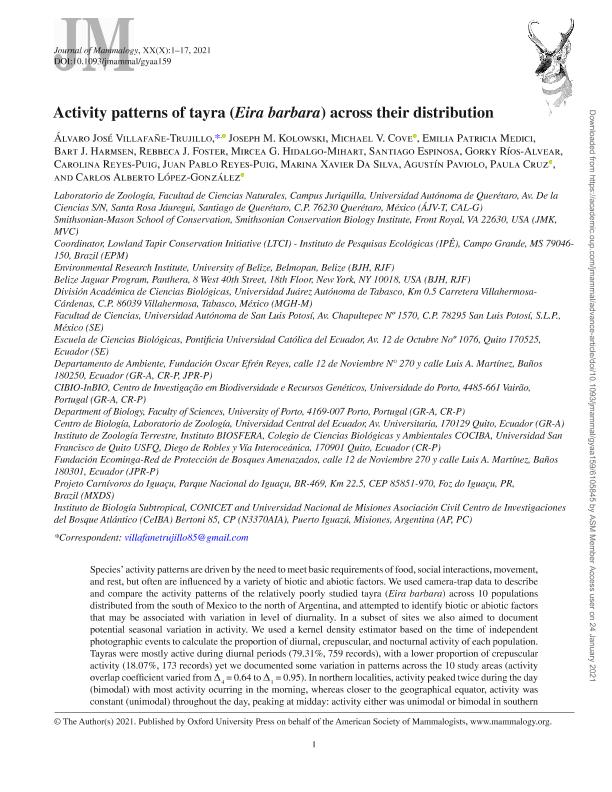Mostrar el registro sencillo del ítem
dc.contributor.author
Villafañe Trujillo, Álvaro José
dc.contributor.author
Kolowski, Joseph M.
dc.contributor.author
Cove, Michael V.
dc.contributor.author
Medici, Emilia Patricia
dc.contributor.author
Harmsen, Bart J.
dc.contributor.author
Foster, Rebbeca J.
dc.contributor.author
Hidalgo Mihart, Mircea G.
dc.contributor.author
Espinosa, Santiago
dc.contributor.author
Ríos Alvear, Gorky
dc.contributor.author
Reyes Puig, Carolina
dc.contributor.author
Reyes Puig, Juan Pablo
dc.contributor.author
Da Silva, Marina Xavier
dc.contributor.author
Paviolo, Agustin Javier

dc.contributor.author
Cruz, Paula Andrea

dc.contributor.author
López González, Carlos Alberto
dc.date.available
2023-10-09T15:00:43Z
dc.date.issued
2021-01
dc.identifier.citation
Villafañe Trujillo, Álvaro José; Kolowski, Joseph M.; Cove, Michael V.; Medici, Emilia Patricia; Harmsen, Bart J.; et al.; Activity patterns of tayra (Eira barbara) across their distribution; Alliance Communications Group Division Allen Press; Journal of Mammalogy; 102; 3; 1-2021; 772-788
dc.identifier.issn
0022-2372
dc.identifier.uri
http://hdl.handle.net/11336/214527
dc.description.abstract
Species' activity patterns are driven by the need to meet basic requirements of food, social interactions, movement, and rest, but often are influenced by a variety of biotic and abiotic factors. We used camera-trap data to describe and compare the activity patterns of the relatively poorly studied tayra (Eira barbara) across 10 populations distributed from the south of Mexico to the north of Argentina, and attempted to identify biotic or abiotic factors that may be associated with variation in level of diurnality. In a subset of sites we also aimed to document potential seasonal variation in activity. We used a kernel density estimator based on the time of independent photographic events to calculate the proportion of diurnal, crepuscular, and nocturnal activity of each population. Tayras were mostly active during diurnal periods (79.31%, 759 records), with a lower proportion of crepuscular activity (18.07%, 173 records) yet we documented some variation in patterns across the 10 study areas (activity overlap coefficient varied from Δ4 = 0.64 to Δ1 = 0.95). In northern localities, activity peaked twice during the day (bimodal) with most activity ocurring in the morning, whereas closer to the geographical equator, activity was constant (unimodal) throughout the day, peaking at midday: activity either was unimodal or bimodal in southern localities. Despite investigating multiple potential abiotic and biotic predictors, only latitude was associated with variation in the proportion of diurnal activity by tayras across its range, with increased diurnal activity closer to the equator. Seasonal comparisons in activity showed a tendency to reduce diurnality in dry versus rainy seasons, but the pattern was not consistently significant. This is the most comprehensive description of tayra activity patterns to date, and lends novel insight into the potential flexibility of the species to adapt to local conditions.
dc.format
application/pdf
dc.language.iso
eng
dc.publisher
Alliance Communications Group Division Allen Press

dc.rights
info:eu-repo/semantics/openAccess
dc.rights.uri
https://creativecommons.org/licenses/by-nc-sa/2.5/ar/
dc.subject
ANÁLISIS DE SOBREPOSICIÓN
dc.subject
CAMERA TRAP
dc.subject
CARNIVORES
dc.subject
CARNIVOROS
dc.subject
CATASTRO NO-INVASIVO
dc.subject
CÁMARAS TRAMPA
dc.subject
MUSTELIDAE
dc.subject
MUSTELIDAE
dc.subject
NEOTROPICS
dc.subject
NEOTRÓPICO
dc.subject
NONINVASIVE SURVEY
dc.subject
OVERLAP ANALYSES
dc.subject.classification
Ecología

dc.subject.classification
Ciencias Biológicas

dc.subject.classification
CIENCIAS NATURALES Y EXACTAS

dc.title
Activity patterns of tayra (Eira barbara) across their distribution
dc.type
info:eu-repo/semantics/article
dc.type
info:ar-repo/semantics/artículo
dc.type
info:eu-repo/semantics/publishedVersion
dc.date.updated
2022-03-29T19:03:53Z
dc.journal.volume
102
dc.journal.number
3
dc.journal.pagination
772-788
dc.journal.pais
Estados Unidos

dc.journal.ciudad
Lawrence
dc.description.fil
Fil: Villafañe Trujillo, Álvaro José. Universidad Autonoma de Queretaro.; México
dc.description.fil
Fil: Kolowski, Joseph M.. Instituto de Pesquisas Ecológicas; Brasil
dc.description.fil
Fil: Cove, Michael V.. University of Belize; Belice
dc.description.fil
Fil: Medici, Emilia Patricia. Instituto de Pesquisas Ecológicas; Brasil
dc.description.fil
Fil: Harmsen, Bart J.. University of Belize; Belice
dc.description.fil
Fil: Foster, Rebbeca J.. University of Belize; Belice
dc.description.fil
Fil: Hidalgo Mihart, Mircea G.. Universidad Juárez Autónoma de Tabasco,; México
dc.description.fil
Fil: Espinosa, Santiago. Universidad Autónoma de San Luis Potosí; México
dc.description.fil
Fil: Ríos Alvear, Gorky. Universidad de Porto; Portugal
dc.description.fil
Fil: Reyes Puig, Carolina. Universidad de Porto; Portugal
dc.description.fil
Fil: Reyes Puig, Juan Pablo. Universidad de Porto; Portugal
dc.description.fil
Fil: Da Silva, Marina Xavier. Universidad Central del Ecuador; Ecuador
dc.description.fil
Fil: Paviolo, Agustin Javier. Consejo Nacional de Investigaciones Científicas y Técnicas. Centro Científico Tecnológico Conicet - Nordeste. Instituto de Biología Subtropical. Universidad Nacional de Misiones. Instituto de Biología Subtropical; Argentina
dc.description.fil
Fil: Cruz, Paula Andrea. Consejo Nacional de Investigaciones Científicas y Técnicas. Centro Científico Tecnológico Conicet - Nordeste. Instituto de Biología Subtropical. Universidad Nacional de Misiones. Instituto de Biología Subtropical; Argentina
dc.description.fil
Fil: López González, Carlos Alberto. Universidad Autonoma de Queretaro.; México
dc.journal.title
Journal of Mammalogy

dc.relation.alternativeid
info:eu-repo/semantics/altIdentifier/url/https://academic.oup.com/jmammal/advance-article/doi/10.1093/jmammal/gyaa159/6105845
dc.relation.alternativeid
info:eu-repo/semantics/altIdentifier/doi/http://dx.doi.org/10.1093/jmammal/gyaa159
Archivos asociados
